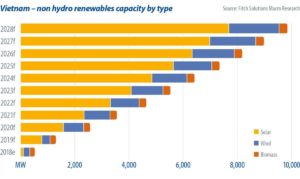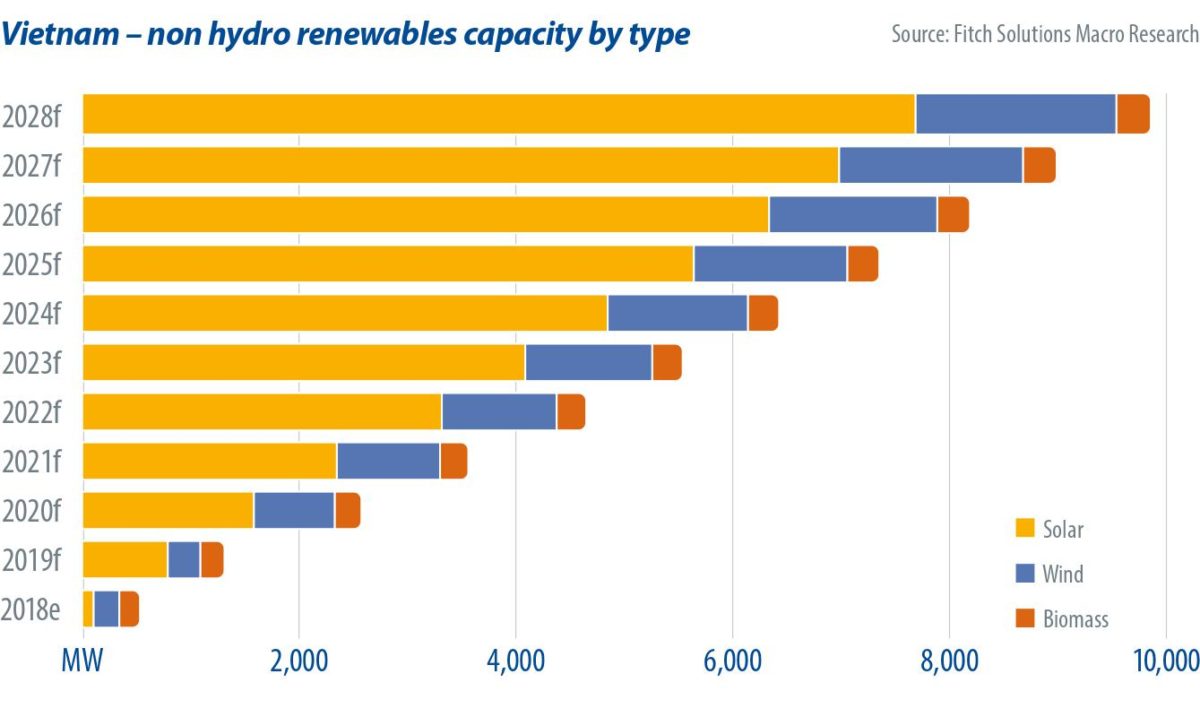 Vietnam’s solar opportunities shine bright
Vietnam’s solar opportunities shine bright
The outlook for growth in Vietnam’s renewables sector is positive, writes Daine Loh, research analyst at Fitch Solutions. And the solar segment is one of the key drivers of this impressive growth. Vietnam still has substantial untapped solar power potential. Coupled with an increasingly supportive regulatory environment, and an expected surge in electricity consumption over the next decade, the country’s renewables sector is poised for a new dawn. And this will bring substantial opportunities for investors.
December 23, 2019 Daine Loh, power and renewables research analyst, Fitch Solutions
Vietnam is set for a surge in power demand and consumption over the coming decade, which will stimulate the need for the rapid development of new power capacity. This stems largely from an expanding industrial and manufacturing sector, particularly as the ongoing U.S.-China trade war plays out. This has allowed Vietnam’s government to position itself outside of China’s shadow – a move to create an alternate manufacturing hub amid geopolitical uncertainties. Positive demographics and rapid urbanization will also further stoke electricity consumption growth rates in Vietnam, which Fitch forecasts to grow by an annual average of 6.7% between 2019 and 2028 – one of the fastest rates in Asia.
We believe that the government will prioritize the development of the power sector to support the country’s strong and stable economic growth, which Fitch Solutions Macro Research’s Country Risk team forecasts to come in at 6.9% in 2019 and 6.8% in 2020. Vietnam’s large manufacturing sector, which accounts for nearly 17% of GDP, also makes improving energy security crucial to sustaining Vietnam’s growth momentum over the longer term.
While the government will focus largely on coal power capacity expansions to meet the coming surge in power demand, renewables will offer complementary growth opportunities, particularly with the increasing environmental consciousness and pollution concerns against the use of coal. Solar power, particularly distributed rooftop solar, is an attractive option for emerging markets to meet power demand, as it requires a shorter development time compared to thermal power projects, and has the ability to bypass some infrastructural shortfalls such as grid bottlenecks or land availability issues.
Regulatory bright spot
Fitch’s view is also informed by an increasingly supportive policy and regulatory environment for the renewables sector. Based on the country’s latest power development plan, the government aims to install 4 GW of solar capacity by 2025, and 12 GW by 2030. In an attempt to encourage foreign investments and growth in the sector, the government offers some preferential policies, attractive feed-in-tariffs and other financial incentives such as preferential tax and duty levies. Notably, the government has introduced a new direct power purchase agreement (DPPA), where renewable energy producers can sell and deliver electricity directly to corporate customers. The government is also looking to draft a new power development plan by June 2020, and we believe that non-hydro renewables will likely see a greater focus.
While a proposed 20% cut to the FIT for ground-mounted and floating solar capacity in place since September could curb investor interest somewhat, we believe that the new FITs of $70.90 and $76.90/MWh for the two solar sub-segments respectively will remain high enough to attract investors – as auctions push prices down substantially in most alternative solar markets.
Furthermore, we believe that this will be partially offset by the falling technology costs for solar. Chinese solar component manufacturers are already facing a supply glut, due to slowing domestic solar growth and restricted access to the U.S. and Indian markets, which has led to downward pressure on solar module prices across the globe over the past two years. Additionally, some Chinese manufacturers have also set up manufacturing capacity in Vietnam to circumvent trade duties, and the presence of a local supply chain further lowers the prices for domestic use.
Dawn of a new era
As a result, Vietnam has seen growing investor interest and a strengthening pipeline of solar energy projects, supporting our positive growth outlook. A notable uptick in solar project approvals by the government since 2017 has boosted the country’s project pipeline significantly.
Most notably, the Da Nhim–Ham Thuan–Da Mi Hydro Power Joint Stock Company (DHD) secured a $37 million financing agreement with the Asian Development Bank in October to develop a 47.5 MW floating solar plant at the Da Mi Hydropower plant, which will be one of the largest floating solar installations in the region.
Other significant developments in the sector this year included the operation and grid-connection of several firsts across various provinces, such as the 50 MW Cát Hiệp Solar Power Plant in Bình Đinh, the 275 MW Hòa Hội Solar Power Plant in Hà Tĩnh, and the 100 MW Srepok 1 and Quang Minh Solar Power Plant Complex in Đắk Lắk.
As development continues, investors are likely to find bright spots for investment in solar power across Vietnam.
About the author
Daine Loh is a power and renewables research analyst at Fitch Solutions, with a primary focus on markets in the Asia-Pacific region, as well as the global solar market. She is responsible for the analysis of key trends and developments in the energy sector, as well as forecasting and identifying actionable investment themes for the power and renewables space. Previously, she held roles in strategic research and analysis at Singapore’s Ministry of Trade and Industry and at the US-ASEAN Business Council. She holds a B.Soc.Sci. (Hons.) degree in political science from the National University of Singapore, with a strong interest in international political economics and renewable energy.
Source: https://www.pv-magazine.com/2019/12/23/vietnams-solar-opportunities-shine-bright/



